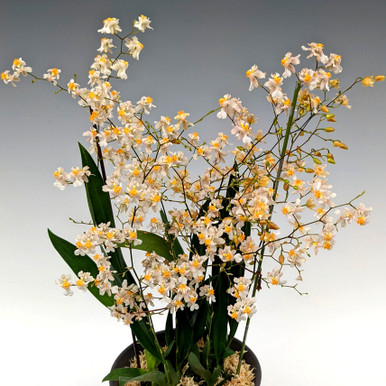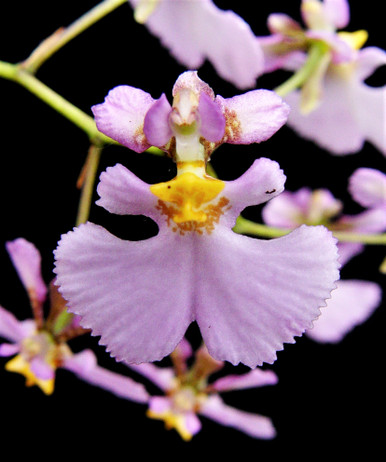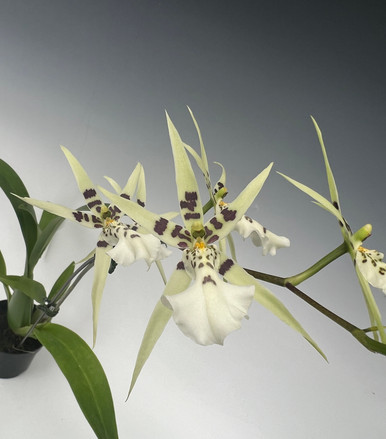Tolumnia Orchid Care
Tolumnia are miniature Equitant Oncidiums that originate in the Caribbean. These are great compact plants that are easy to grow for any beginner. These plants can often bloom more than once a year. Larger specimen plants or large collections of Equitants can provide some blooms most of the year round. Equitants come in many shades of colors and have flowers that can be solid in color, spotted or barred.
Light and Shade
These delicacies can be found growing in their native habitats on small twigs at the ends of trees in high light exposed conditions. Therefore, they do well growing in an east window receiving sunlight from early in the morning until 11:00 or 11:30 a.m. They can also be grown in a south window as long as a sheer curtain is used to diffuse the light. If you are growing the plants under fluorescent lights, be sure you supply some incandescent light to make up for the end of the light spectrum. This will insure proper blooming. L.E.D. Grow Lights can provide more than enough light for healthy growth and frequent blooming. The artificial light market has expanded greatly in recent years, so a quick Google search will result in a variety of lighting options and price ranges.
Temperature and Humidity
Tolumnia enjoy intermediate conditions, with daytime temperatures ranging from 70°F to 80°F (21°C to 27°C), and nighttime temparatures of 60°F to 65°C (16°C to 18°C). Tolumnia benefit from humidity levels between 50% and 70%. If provided enough humidity, Tolumnia can be grown without any potting medium whatsoever. We recommend that you lightly pack New Zealand Sphagnum Moss around the roots to provide moisture to the roots. Humidity at home can be increased with the use of a humidifier.
Watering
If grown bare root, Tolumnia should be wetted or misted daily. For potted Tolumnia, plants should be watered once the media has dried entirely. This generally occurs every 7 days from the previous watering. If in doubt, do not water and wait another day or two. Remember that small plants in clay pots can dry out within a couple of days. Plants should never stand in water. Make sure to water more often when Tolumnia are about to bloom, and throughout the blooming period. When repotting your Tolumnia during the active growing season, do not water the media for at least 3 days. This allows cuts and breaks in the roots to callous and avoid rotting upon being watered. We always recommend watering in the morning, as this gives the leaves time to dry and avoid bacterial growth overnight. If possible, use water low in alkalinity, such as rainwater, distilled water, or reverse osmosis water. If you have a dehumidifier in your home, the water that collects in the tray is excellent for watering orchids.
Feeding
We highly recommend Green Jungle Orchid Food, specially formulated to provide orchids with the nutrients they would naturally encounter in their wild habitats. This is the fertilizer that we developed to use on our own plants in production, with excellent results for decades! This formula works best with water low in alkalinity (such as rainwater, distilled water, or reverse osmosis water). However, you may use tap water, keeping in mind that mineral buildup will require repotting more frequently, on the order of every 1 to 2 years. If potting in bark mix, fertilize every time you water during the growing season, flushing with non-softened water once a month. This rinses the media of salt and mineral buildup. During periods of inactive growth, fertilize every other watering. If potting in sphagnum moss, fertilize every 3rd watering year round.
Potting
Tolumnia can be grown mounted or in pots. For most household conditions, pots are best because they hold more moisture around the roots. At Orchids Limited, we recommend growing Tolumnia mounted on a cork slab on a bed of New Zealand Sphagnum Moss. However, Tolumnia can also be potted using New Zealand Sphagnum Moss or the Medium grade of our Traditional Orchid Bark Mix if grown in pots. To avoid the transfer of orchid diseases, it is standard procedure to sterilize all cutting and potting instruments before using them on a plant. This can be done by flaming pruning shears with a butane torch, or by spraying with rubbing alcohol and wiping with a clean paper towel.
Featured Products
Shop all →





